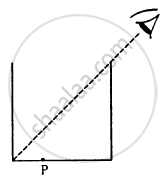Advertisements
Advertisements
प्रश्न
A biconvex thick lens is constructed with glass (μ = 1.50). Each of the surfaces has a radius of 10 cm and the thickness at the middle is 5 cm. Locate the image of an object placed far away from the lens.
उत्तर
Given,
Biconvex lens with each surface has a radius (R1 = R2 = R) = 10 cm,
and thickness of the lens (t) = 5 cm
Refractive index of the lens (μ) = 1.50
Object is at infinity (∴ u = ∞ )
First refraction takes place at A.
We know that,
\[\frac{\mu_g}{v} - \frac{\mu_a}{u} = \frac{\mu_g - \mu_a}{R}\]
\[ \Rightarrow \frac{1 . 5}{v} - \left( - \frac{1}{\infty} \right) = \frac{1 . 5 - 1}{10}\]
\[ \Rightarrow \frac{1 . 5}{v} = \frac{0 . 5}{10}\]
\[ \Rightarrow v = 30 \text{ cm }\]
Now, the second refraction is at B.
For this, a virtual object is the image of the previous refraction.
Thus, u = (30 − 5) = 25 cm
\[\frac{\mu_a}{v} - \frac{\mu_g}{u} = \frac{\mu_a - \mu_g}{R}\]
\[ \Rightarrow \frac{1}{v} - \frac{1 . 5}{25} = \frac{1 - 1 . 5}{10}\]
\[ \Rightarrow \frac{1}{v} - \frac{1 . 5}{25} = \frac{- 0 . 5}{10}\]
\[ \Rightarrow v = 9 . 1 cm\]
Hence, the image is formed 9.1 cm far from the second refraction or second surface of the lens.
APPEARS IN
संबंधित प्रश्न
Give a scientific reason:
Danger signals are red in colour.
Why does unpolarised light from a source show a variation in intensity when viewed through a polaroid which is rotated?
Draw the intensity distribution for the fringes produced in interference ?
In the meterbridge experimental set up, shown in the figure, the null point ‘D’ is obtained at a distance of 40 cm from end A of the meterbridge wire. If a resistance of 10Ω is connected in series with R1, null point is obtained at AD = 60 cm. Calculate the values of R1 and R2.
Describe briefly using a diagram how sunlight is polarised ?
The image formed by a concave mirror
Locate the image of the point P as seen by the eye in the figure.

A cylindrical vessel, whose diameter and height both are equal to 30 cm, is placed on a horizontal surface and a small particle P is placed in it at a distance of 5.0 cm from the centre. An eye is placed at a position such that the edge of the bottom is just visible (see figure). The particle P is in the plane of drawing. Up to what minimum height should water be poured in the vessel to make the particle P visible?

An optical fibre (μ = 1.72) is surrounded by a glass coating (μ = 1.50). Find the critical angle for total internal reflection at the fibre-glass interface.
Light falls from glass (μ = 1.5) to air. Find the angle of incidence for which the angle of deviation is 90°.
Answer the following question in detail.
Is it possible to see primary and secondary rainbow simultaneously? Under what conditions?
Pick the wrong answer in the context with rainbow.
Rainbow is the phenomenon due to ______.
A plano-convex lens is made of material having refractive index 1.5. The radius of curvature of curved surface is 40 cm. The focal length of the lens is ____________ cm.
State any one difference between a primary rainbow and a secondary rainbow.
Explain the formation of primary and secondary rainbow.
| Case study: Mirage in deserts |
 |
|
To a distant observer, the light appears to be coming from somewhere below the ground. The observer naturally assumes that light is being reflected from the ground, say, by a pool of water near the tall object. Such inverted images of distant tall objects cause an optical illusion to the observer. This phenomenon is called mirage. This type of mirage is especially common in hot deserts. Based on the above facts, answer the following question : |
In an optical fibre, if n1 and n2 are the refractive indices of the core and cladding, then which among the following, would be a correct equation?
The sky would appear red instead of blue if
Between the primary and secondary rainbows, there is a dark band known as Alexandar’s dark band. This is because ______.
- light scattered into this region interfere destructively.
- there is no light scattered into this region.
- light is absorbed in this region.
- angle made at the eye by the scattered rays with respect to the incident light of the sun lies between approximately 42° and 50°.
